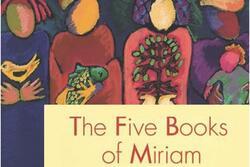Loving Judith
Artemisia Gentileschi's "Judith Slaying Holofernes" via Wikimedia Commons.
When I was sixteen, I enrolled in an advanced placement art history class at my high school because I wanted to impress my mother, an artist. Since birth, I have been woefully inept with paints and brushes, but ravenous for the stories behind artistic creation. I wanted to study my mother’s inspirations, to delight in a shared interest and gain access to a world that felt out of my grasp. I devoured The Yellow House and spent hours creating flashcards for vases of the Ancient Near East. Art history, even as an introductory course, gave me a chance to relax into aesthetics for an hour each weekday, breaking up the general high school monotony of Calculus and French.
It was halfway through our Baroque unit that I discovered Judith. Biblical and mythological accounts say she lived during the 2nd century B.C.E, in Bethulia, a city-state that fell under siege by the Assyrians. The imposing army was led by a general named Holofernes, whose reputation for cruelty preceded him. Judith feared the extinction of her people and her Jewish faith if Bethulia fell. She asked for God’s favor, and took matters into her own hands. With the help of a maid, she crept into the Assyrian camp, offering herself as a Trojan Horse to a leering Holofernes. He invited her to dine, and the rest is history—she fed him cheese until his thirst demanded wine, and when he fell into a stupor, she took his sword from his side and decapitated him. She carried the head in a handbasket back to the Israelites. Spurred into action by her stealth, they launched a surprise attack on the Assyrians and successfully pushed them out of Bethulia. Her story became intertwined with Hanukkah almost certainly by coincidence— Jewish scholars of the medieval period seemed to categorize her into Hanukkah midrashes by virtue of Judith sounding an awful lot like Judah.
In terms of religious significance, Judith is less canon and more fan-favorite. While her story was almost certainly recorded by early Jews, it is, by all accounts, a fable. This was no problem for the great painters of the last millennium. She wasn’t just a particularly striking rendition on canvas—she was an entire genre of art. To Caravaggio in 1598, she was youthful and incredulous, her brow furrowed in surprise as she tilted the blade lodged in Holofernes’s neck. For Artemisia Gentileschi in the 1600s, Judith was more practiced, leaning into her task, her expression stoic. In 1537, Lucas Cranach the Elder painted her smugly, her hand resting atop the severed head that represented the Jewish people’s triumph over the Assyrians. I adored every interpretation I laid my eyes on.
Gentileschi completed several renditions of Judith, but her depiction of the beheading itself is by far the most recognizable. This was the painting that got my mother and me talking about art the way I’d imagined we would. I had my textbook open, the light in our kitchen bouncing off the gloss and sheen on the page. “Oh, Judith!” she said, pausing at the table with me and letting her hand rest over Holofernes’s bleeding neck. “I love this painting. It’s like a train wreck, you can’t look away from the gore—but the expression on her face is priceless.” She tapped Judith’s steely gaze and smiled. I was elated that we were drawn to the same elements of the painting—the light work, the shine of the blade, and the overwhelming physicality of the work. I was further entranced when she mentioned a fact overlooked in my textbook: Gentileschi, a woman painting in an era when her craft was not valued like that of her male contemporaries, painted Holofernes to resemble her rapist. Her rendition of Judith is a self-portrait—allowing her to wield a sword and take revenge, if only in fantasy. Judith Slaying Holofernes was the first piece of feminist art that really moved me. Even now, I get chills when I view it.
I thought a lot about Judith this week, after dusting off my menorah and dutifully buying candles and gelt. Hanukkah began on Sunday, a hazy slip into the holiday season that seemed to come out of nowhere. On the first night, my partner worked on dinner as I lit the candles and uncorked wine. As I plated hors d'oeuvres, I remarked that it was appropriate to indulge in salty cheese and sharp wine, because it’s how Jews are meant to celebrate Judith during Hanukkah.
My partner looked at me blankly. “Who’s Judith?”
I stared back, equally blank. “Judith? She fed Holofernes cheese, and so he got thirsty and drank too much wine, and then she beheaded him?”
My partner shook his head, dumbfounded and a little frightened.
“It’s not in the Torah! But it’s why we eat dairy on Hanukkah, I promise!”
I raced off to the other room, dragged my laptop into the kitchen, and searched for an image of the painting I knew by heart. We spent our dinner watching the candles burn down, discussing Baroque painting, the history of the Assyrians, Judith’s relevance to modern Jewish feminism, and how she came to be associated with Hanukkah in the first place. The conversation felt natural, like I was coming full-circle from art history novice to an authority on a piece of art that mattered to me. I felt the same energy with my partner I had felt seven years ago at the kitchen table with my mother, and texted her a picture of the painting, devoid of context, as my partner put away the dishes.
She wrote back, “Gross. Happy Hanukkah!”








It's a great story.
I wonder how many Judys there are who know your story.